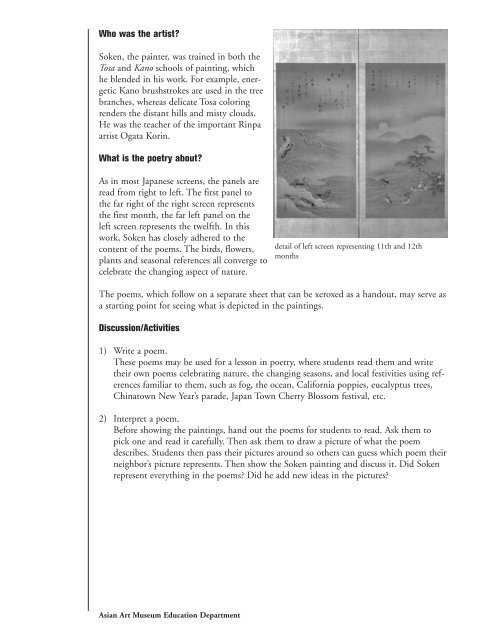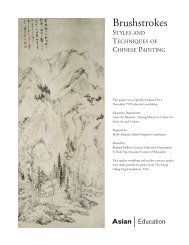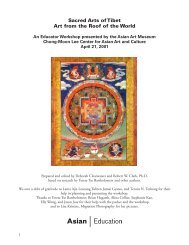Download PDF - Asian Art Museum | Education
Download PDF - Asian Art Museum | Education
Download PDF - Asian Art Museum | Education
You also want an ePaper? Increase the reach of your titles
YUMPU automatically turns print PDFs into web optimized ePapers that Google loves.
Who was the artist?<br />
Soken, the painter, was trained in both the<br />
Tosa and Kano schools of painting, which<br />
he blended in his work. For example, energetic<br />
Kano brushstrokes are used in the tree<br />
branches, whereas delicate Tosa coloring<br />
renders the distant hills and misty clouds.<br />
He was the teacher of the important Rinpa<br />
artist Ogata Korin.<br />
What is the poetry about?<br />
As in most Japanese screens, the panels are<br />
read from right to left. The first panel to<br />
the far right of the right screen represents<br />
the first month, the far left panel on the<br />
left screen represents the twelfth. In this<br />
work, Soken has closely adhered to the<br />
content of the poems. The birds, flowers,<br />
plants and seasonal references all converge to<br />
celebrate the changing aspect of nature.<br />
detail of left screen representing 11th and 12th<br />
months<br />
The poems, which follow on a separate sheet that can be xeroxed as a handout, may serve as<br />
a starting point for seeing what is depicted in the paintings.<br />
Discussion/Activities<br />
1) Write a poem.<br />
These poems may be used for a lesson in poetry, where students read them and write<br />
their own poems celebrating nature, the changing seasons, and local festivities using references<br />
familiar to them, such as fog, the ocean, California poppies, eucalyptus trees,<br />
Chinatown New Year’s parade, Japan Town Cherry Blossom festival, etc.<br />
2) Interpret a poem.<br />
Before showing the paintings, hand out the poems for students to read. Ask them to<br />
pick one and read it carefully. Then ask them to draw a picture of what the poem<br />
describes. Students then pass their pictures around so others can guess which poem their<br />
neighbor’s picture represents. Then show the Soken painting and discuss it. Did Soken<br />
represent everything in the poems? Did he add new ideas in the pictures?<br />
<strong>Asian</strong> <strong>Art</strong> <strong>Museum</strong> <strong>Education</strong> Department
















